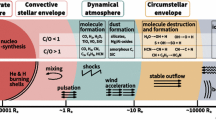Abstract
The stars in the Main Sequence are seen as a hierarchy of objects with different massesM and effective dynamical radiiR eff=R/α given by the stellar radii and the coefficients for the inner structure of the stars.
As seen in a previous work (Paper I), during the lifetime in the Main SequenceR eff(t) remains a near invariant when compared to the variation in the time ofR(t) and α(t).
With such an effectiveR eff one obtains the amounts of actionA c(M), the effective densities ρeff(M)=ρ(M)α3(M), the densities of action and of energy (or mean presures in the stellar interior)a c(M),e c(M), and the potential energiesE p(M).
The amounts of action areA c∝M k withk≈1.87 for the M stars,k≈5/3 for the KGF stars, andk≈1.83 for the A and earlier stars, representing very simples conditions for the other dynamical parameters. For instancek≈5/3 means a near invariant effective density αeff for the KGF stars, while for such stars the mean densities and coefficients α present the strongest variations with masses ρ(M)∝M −1.81, α(M)∝M0.6.
The cases for the M stars (e c(M)∝M −1) and for the A and earlier stars (betweena c(M)=constant and αeff(M)∝M −1) and also discussed. These conditions for the earlier stars also represent reasonable mean values for the whole stellar hierarchy in the range of masses 0.2M ⊙≤M≤25M ⊙.
With all this, one can build ‘dynamical’ HR diagrams withA c(M), Ep(M), αeff M −p, etc., whose characteristics are analogous to these in the photometrical HR diagram. A comparison is made betweenA c(M) from the models here and the HR diagram with the best known stars of luminosity classes IV, V, and white dwarfs.
The comparison of the potential energiesE p(M)∝M −p according to the stellar models used here and the observed frequency function ψ(M∝M −q (number of stars in a given interval of masses) from different authors suggests the possibility that the productE p(M)ψ(M) is a constant, but this must be confirmed with further studies of the function ψ(M) and its fine structure.
There are analogies between the formulation used here for the stellar hierarchy and other physical processes, for instance, in modified forms of the Kolmogorov law of turbulence and in the formulation used for the hierarchy of molecular clouds in gravitational equilibrium. Besides, the function of actionA c(M) for the stars has analogous properties to the relations of angular momenta and massesJ(M) for different types of objects. The cosmological implications of all this are discussed.
Similar content being viewed by others
References
Claret, A. and Gimenez, A.: 1989a,Astron. Astrophys. Suppl. Series 81, 1 (CGa).
Claret, A. and Gimenez, A.: 1989b,Astron. Astrophys. Suppl. Series 81, 137 (CGb).
Claret, A. and Gimenez, A.: 1990,Astrophys. Space Sci. 169, 215 (CGc).
Dames, T. M., Elmegreen, B. G., Cohen, R. S., and Thaddeus, P.: 1986,Astrophys. J.,305, 892.
Eggen, O.: 1987,Astron. J. 92, 419.
Ferronsky, V. I., Denisik, S., and Ferronsky, S. V.: 1978,Celes. Mech. 18, 113.
Ferronsky, V. I., Deniskk, S., and Ferronsky, S. V.: 1978,Celes, Mech. 19, 173.
Ferronsky, V. I., Denisik, S., and Ferronsky, S. V.: 1987,Jacobi Dynamics, Astrophysics Space Science Library, D. Reidel Publ. Co., Dordrecht, Holland.
Franco, G. P., Tarsia, R. D., and Quiroga, R. J.: 1985,Astrophys. Space Sci. 111, 343.
Fitzgerald, M. P. and Raburn, D. R.: 1982, in K. Scheifers and H. H. Voigt (eds.),Landolt Börnstein Neues Series,VI.2, p. 25.
Kiziloglu, N.: 1989,Astrophys. Space Sci. 154, 225.
Kjelsden, H. and Frandsen, S.: 1991,Astro. Astrophys. Suppl. Series 87, 119.
Myers, P. C.: 1983,Astrophys. J. 270, 105.
Quiroga, R. J. and Claret, A.: 1992,Astrophys. Space Sci. 193, 185.
Salomon, P. M., Rivolo, A. R., Barret, J., and Jahil, A.: 1987,Astrophys. J. 319, 730.
Shaya, E. J. and Tully, B. R.: 1984,Astrophys. J. 281, 56.
Wesson, P. S.: 1983,Astron. Astrophys. 119, 313.
Author information
Authors and Affiliations
Rights and permissions
About this article
Cite this article
Quiroga, R.J., Claret, A. The stars in the Main Sequence and their dynamical parameters. Astrophys Space Sci 193, 235–246 (1992). https://doi.org/10.1007/BF00643203
Received:
Issue Date:
DOI: https://doi.org/10.1007/BF00643203




